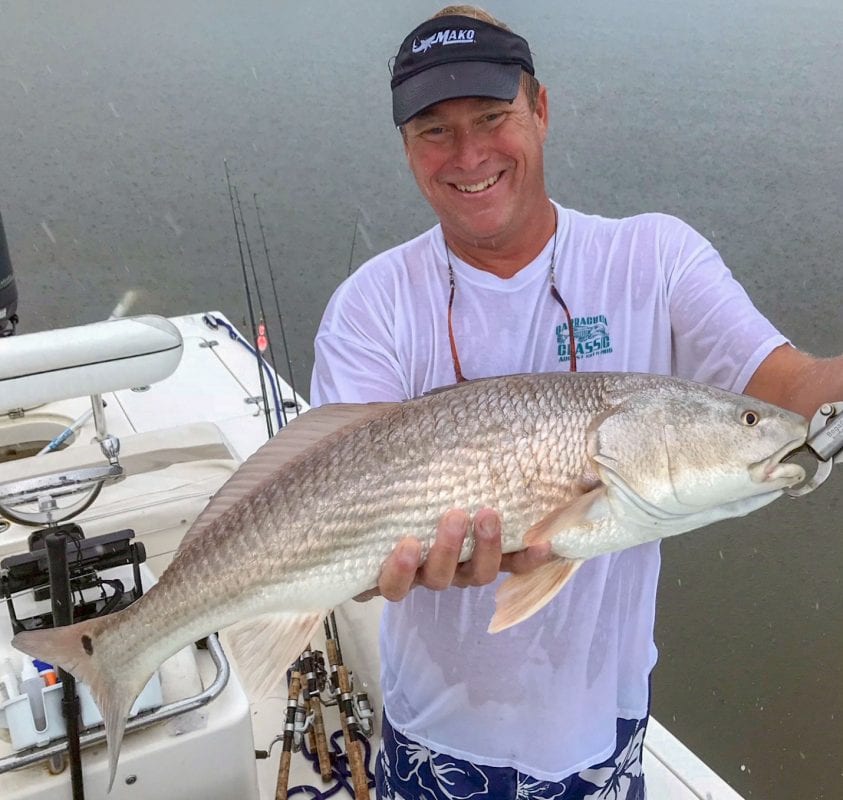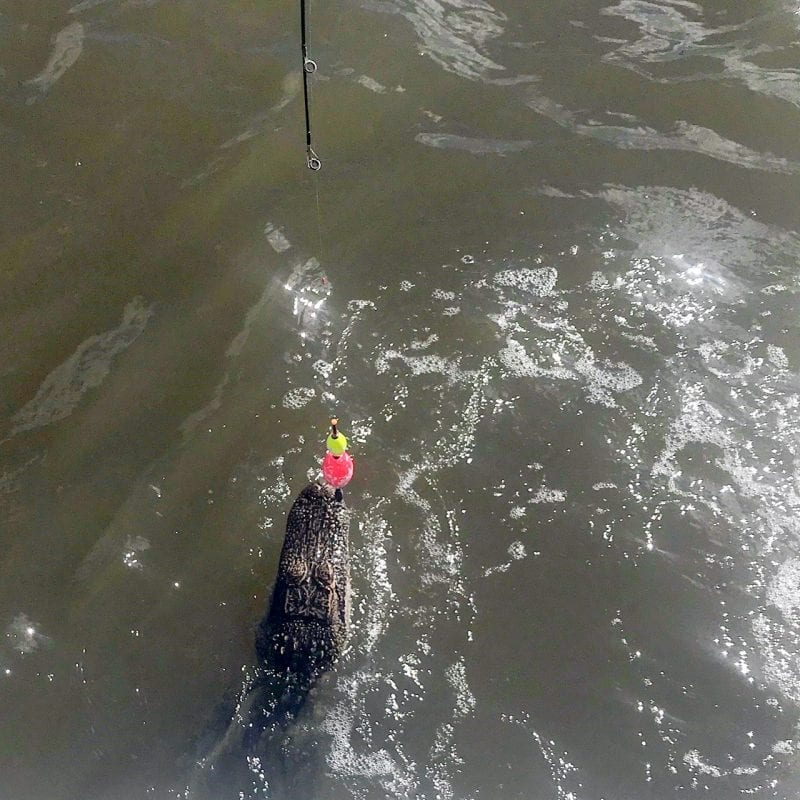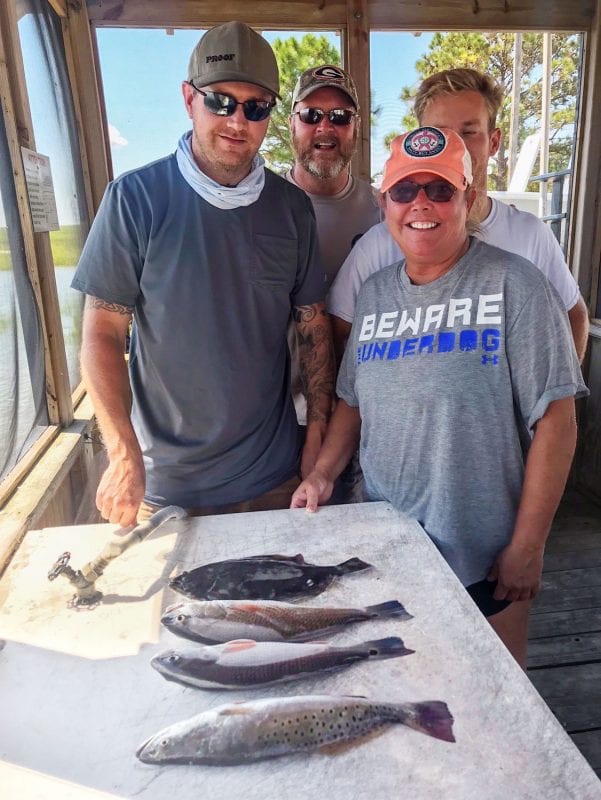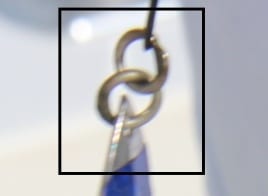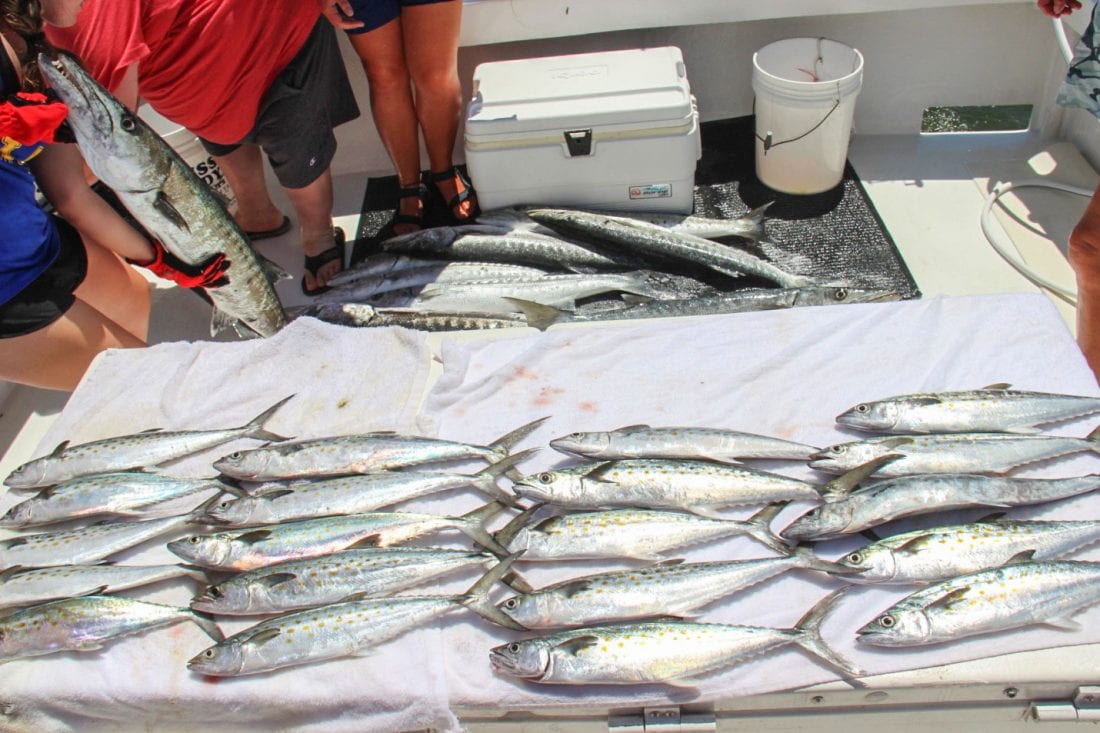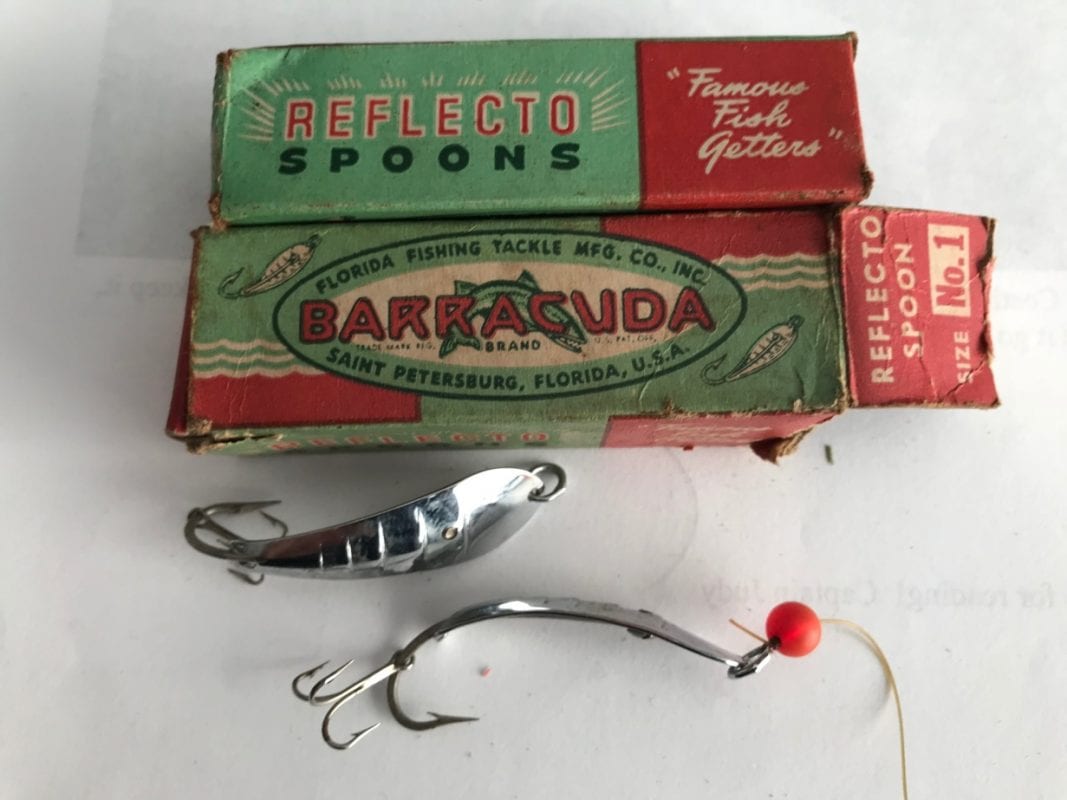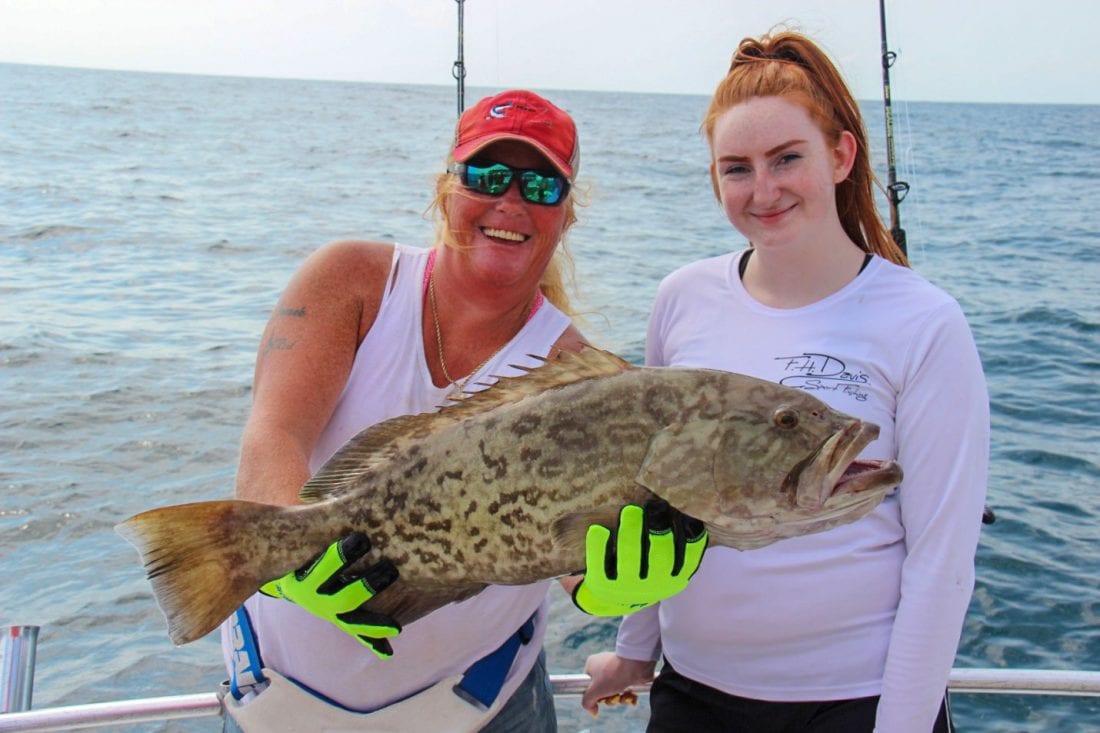While inshore fishing with her father Captain Garrett Ross of Miss Judy Charters 6 year old Stella caught a nice juvenile hammerhead! Yes it was caught fought and released back to the wild! This is the second one of these fish that Captain has caught in the sound.
This picture shows in better detail the shape of a hammerhead shark’s head. We do not see nor catch many of these type sharks in the sound or the ocean. They are by far the one of our strangest looking sharks caught in this area.
Happy Birthday Andrew! While inshore fishing with Kevin Rose of Miss Judy Charters on his birthday Andrew Cree caught this nice trophy red fish! Now I must bring attention to two things! First the fish is happy because he is going to be released! And secondly Andrew is sporting that wonderful fish catching smile! Allison Hit his fishing friend and Captain Kevin showed him the way!
While inshore fishing with Captain Kevin Rose of Miss Judy Charters Andrew Cree’s fishing friend Allison Hit (both from Savannah, Georgia) hooked up this alligator! It was released unharmed! What does this mean? No makings for shoes or pocketbooks on this fish day!
While inshore fishing with Captain Kevin Rose of Miss Judy Charters Stellan Carroll (Savannah) had great time fishing with his father Sam and his grandfather Sam! Who caught the biggest fish? Stellan! Who released the most fish? Stellan! Who caught the most fish? Stellan! Now you know the rest of this fish catching story!
Please meet the Crute fishing team! (Jim Kim and Devin Savannah Zach Crute US NAVY) Who showed them the way? Captain Garrett Ross of Miss Judy Charters
While inshore fishing with Captain Garrett Ross of Miss Judy Charters Crute fishing team had a wonderful day!
While inshore fishing with Captain Garrett Ross of Miss Judy Charters Aaron Hice Tennessee and Travis Ledford Tennessee’s caught some really nice fish! This is what they kept and the rest were released back to the wild!
Artificial Reefs
Captain Kathy Brown of Miss Judy Charters is holding up a nice mackerel that could not pass up the workings of the 31/2 silver drone spoon. This spoon when troll about 6 knots puts on quite a show. Who does it imitate? Bait fish that are shinny that are making way in a funny manner. This is one fish that is lured in by shinny things. However, if they are acting too strange and not life like the strike moment is gone. The drone spoon produces signature moves as it is pulled through the water. When purchasing this spoon I suggest always making sure that they are two rings not just one. The second ring is the one that make the signature moves happen. Now, if you have spoons that don’t have the second ring I suggest adding one! It is easy to do, get out your split ring kit, and just do it!
Double rings!
So far this 2018 season we have had some pretty good Spanish mackerel catches. However, it seems we have had to do a little trolling tricking to get this biting job done! Before the month of August you don’t get to see a lot of these fish getting air! (Jumping out of the water!) According to my father, Spanish don’t start jumping until about first week in August. And there is more….They only jumped to get rid of their eggs. Back in the old days, they really started jumping a lot during this time.
Before the month of August and as early as April these fish are here, but you don’t see them. Trolling or pitching and letting spoon sink over structure located in less than 60 feet of water should yield you some action. Of course light tackle is the key to get the most bite attention from these fish! I called it the Twenties! Why? I like using 20 pound test main line and 20 pound test leaders. However, if you start to lose spoons I suggest up scaling to 30 pound test leader. However, seemly you do catch more Spanish on 20 than you do 30 pound test.
In the charters business we use #1, #2, and #3 planers. Why? It gets the spoons to the right feeding depth. And believe me when trolling in 45 feet of water it is nice to be fishing with some Like Captain Ken or Captain Deidra or Captain Ryan so that I can call and ask, “What size planners are working?” It certainly does eliminate a lot of trial and error! Most of us use 20 to 25 to 30 pound test monofilament leader. (Plain old monofilament line) And we all concur that going with about 15 to 20 feet of leader between the back of the planer to the spoon. Concurring in our fish catching game is a good thing!
Let’s talk about the right spoon to use! It‘s most likely the oldest, most used, and proven by the fish by the attention it gets..The Clark Spoon is number one! Now I am not saying that no other spoons/baits will work, because they will. However, if you have to purchase get yourself some Clark Spoons. The size that works for us is 0 and 00 size. These lures come in many sizes. Pick one!
Captain Alan Collins of Miss Judy Charters found these “old school” lures in his father’s old tackle box. He handed me a box that had these two old Spanish mackerel type spoon in each one. As you can see the spoon comes with small treble hook in tow. What does this mean? Just about every time you get a hit you get hooked up! One of the boxes had a line hanging out of it. This is when I realized that Mr. Collins added his own red ball, which really made this spoon a mackerel attractor a big time catcher hookup!
Alli-Cat DeYoung of Savannah, Georgia is holding up a very nice king mackerel! She caught this king while fishing with her father Dan. While using live menhaden for bait rigged on light tackle this fish didn’t make a pass, it took the bait! Back in the real old days, we had a nickname for king mackerel we called them “Brown Eyes!” It seemed the bigger the fish the browner the eyes! It is a known fact that the bigger a king mackerel get the more it sees with those large brown eyes. According to old school tactics, if a large kings even looked at your bait and didn’t seen anything suspicion you couldn’t stop it from making a solid hit. We would use small Spanish mackerel for bait. This bait didn’t have to be alive it just had to have that newly caught mackerel shine! To keep our bait shinny we used to lay them on ice and never in icy water. How did we accomplish this? Never put the plug in the cooler!
Savannah Snapper Banks
While offshore fishing with Captain Judy and Captain Kathy Jamee Barnard and her daughter Angel had one heck of a catching time! Jamee is holding Angel just caught fought and landed gag grouper! I must add it was a family affair that got this catching job done! Much more next week!
Little Miss Judy’s Believe it or not!
We Got Ship Worms! Oh My!
(Also known as Teredo Worms)
I ask my good friend Captain Steve “Triple Trouble” Howell to do a little checking on the web to see what he could find out these darn worms. He is a whiz at this sort of stuff! As it turns out the so called ship worms are not worms at all. They are basically in the saltwater clam family. They have long, soft, naked bodies. (See the one in the picture above!) And are armed with a set of shell choppers, which over short periods of time they can single handily do quite a bit of damage!
As we painted the bottom of my boat I happened to notice a small opening on the transducer block. Once I picked at it, thinking it was a bit of rot in the wood, I found myself face to face with an alive live in! Talk about great conversation piece, well, we had it! I found this ship worm rasping its way through the only piece of wood attached to the bottom of my boat Miss Judy Too. In 1994, when the boat builder installed the transducer for my fish finder, he used a block of marine tapered wood. Twenty-four years later I found that my transducer had become home for a pretty good size ship worm. If you look at the picture above you can see the assortment of tunnels that this worm made while using its fine set of lips that are really shells. Worms come equip with their own set of shell teeth, which are capable of making ¼ inch holes. Once embedded it just eats its way through and around until there is nothing else to burrow into. At this time I do not know if this was the original worm that start this mayhem, but no matter it is over now and it is paying the ultimate cost!
Now here are some interesting facts about this worm also known as a teredo and/or boring clams! I will never look the same at a clam! Captain Steve “Triple Trouble” Howell our web information finding wizard sent this to me so that I could write this story for you!
Before man ventured out to sea this worm’s sole purpose in life was to tunnel through wood submerged in the sea and to degrade timber that had fallen into the ocean. When man began to traveling the sea wooden ships were built! This provided a grand new feeding world for these worms. Heck, the way I see it, when all of this took place, worms could travel and eat at the same time!
Worms once bored into a ship weakened the hulls to the point that they would break apart in the open sea without any warning! Once ship builders figured all of this out the lathering of hulls era began. First they used wax and then they moved on to lead and tar for covering. There was one good thing that was inspired by the worm’s ability to simply tunnel destroying hundreds of wooden ships causing the lost of many lives. A French engineer, Marc Brunel, devised a method to tunnel under the Thames River in England. How did Marc come up with this first of its kind technique to tunnel under the river bed? Well, you guessed it or not, but the worm showed him the way! He called his technique “Tunneling Shield!” While working in the ship yard and forever observing the tunneling ways of this worm he came to two conclusions. The first…It was possible to take small shell like teeth to precisely tunnel through wood, which prompted him to come up a working “never been though of” drilling method. The second…While the worm tunneled it secretes a calcium-rich framework that coats the inside surface of the tube. What does this do? It keeps the tunnel stable and crushproof. So now you know how Marc came up with this fantastic safe tunneling under the river idea!
Now let’s talk about worm sex! Well, it seems that is one male Teredo (worm) per one thousand females. I will stop and let you all think about this! Once the egg becomes fertilized they are protected inside the mother until they develop. Then they take their place either in the same wood where they are born or find another more suitable spots to make way!
The worms only tunnel parallel to the grain only turning to avoid a knot or any other obstruction. Once worms reach adulthood it could grow lengths of up to one foot and ½ inch thick. Now as I read this I thought this is a big worm. However, apparently not! Its cousin the Giant teredo can grow up to six feet long. Don’t panic would be wooden boat seafarers these giant worms only reside in the muddy bottom of the sea rather than inside of wood!
Now as if it doesn’t get crazier the worm doesn’t even digest the wood that it consumes in order to tunnel through. It has to pass the saw dust through its body and out of it so called tail. This information also states that the worm has to leave it tail end in the water! So what does this mean? Once tunneled in, it leaves an opening, which it secretes its signature coating on. This opening allows the end of the worm’s tale to be exposed. Why? So that all the wood dust and worm poop can be evacuated! And…so it can feed and breath through the tail! I might be wrong, but everything goes out and comes in the same way! Now, there was a lot more explanation on this operation. However, after reading I considered this contents “not really need to know information!”
Now, I know you must be tired of reading about the worm. However, I did find them very interesting. So I will end this part of the story with something that may or may not sit too well on your stomach. In the Pacific Islands they are considered a delicacy. It is called tamilok and is prepared raw as a ceviche! I am stopping here! However, if you want the recipe I am sure Captain Steve “Triple Trouble” Howell can find it!!!
If you have been reading my stuff over the years you already know that I love a good story. Now, sometimes, I have people question where or not they are true! In my case I write about what I was told by my father and heck it must have been true. So we will leave it like that! So therefore according to my father……
Over the years I have talked about this many times! Back in the real old days when ships were made of wood from the top to the bottom they really never knew about the worms. Now I am not talking sea worms that come from the sea, attached themselves to the wood, and rasp their way inside. I am talking about those worms that are already in the wood before the tree it is cut down. I guess it is another chicken or egg story, meaning which came first!
When wooden ships were built builders used the wood that was available. This included the wood that was already milled and with trees that they cut down. The way it was explained was when a ship builder needed a mast; he would go looking for the right size tree and then cut it down. According to my father, after a while trees near the water disappeared first. As time went on ship builders had to change their ways for acquiring materials. But that is not what this story is about!
According to my father, these wood eating worms are already in the wood, which means as the tree grows so do the worms. However, they stayed dormant meaning they aren’t moving they aren’t feeding, and they aren’t reproducing. Now for story sake let’s say a ship builder found three prefect tall trees, which he used all on the same ship. All of these trees unbeknown to the ship builder had a large amount of dormant wood eating worms. Folklore has it that when the worm awakes from their so called long nap or coma they start eating. And they never stop!
Of course I had to ask my father exactly why he thought the worms woke up. Well, he always had a few one liners, which were, I do have to admit, pretty entertaining! There was that bolt of lightning that hit the mast, but did not turn it into thousands of splinters. I called this the Frankenstein Theory! Then he told me that sometimes the atmosphere pressure gets the same above and on the water, which causes a force field to form around the boat. It has happened to me on my boat! The formed electric force field caused everyone’s hair to stick straight up! To this day, why didn’t I take a picture? I still have this day in my memory banks with hopes I never lose it! I call this the St Elmo’s fire theory! I will stop with these two Captain Sherman Helmey theories. It all boils down to the fact that something sent from above wanted the darn worms to awake!
According to my father it took many years of sailing on the high seas before the worm damage took its toll. However, he also said not so many years, if there were lots of worms waking up at the same time. As I write this I have to think about this through the eyes of a child! Why? Because during my youth my father shared with me many interesting stories just like this one! Now here’s the thing…these stories weren’t just about worms, there were all kinds of sea serpents and gods of the sea, talking mermaids with long blonde hair, smart big talking fish that got away, lots of stories about those people that are still living in sunken ships down under, then there was his buddy Big Al Capone with all of their shenanigans, and I think I could go on and on, but I can’t. I need to save some subjects for my next story! And it is going to be a good one too!
Thanks for reading! Captain Judy

